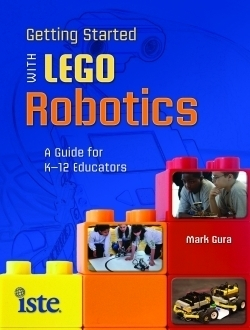Getting Started with LEGO Robotics
A Guide for K-12 Educators
STEM (Science, Technology, Engineering & Math) is an academic area that educators and parents will be hearing a lot about in the future. As a growing economic powerhouse and opportunity to integrate multiple intelligences and key learning objectives across the educational curriculum, robotics is garnering considerable interest and enthusiasm in learning communities throughout the world. Here and abroad, Lego Robotics is changing the way schools are teaching multiple subjects to students of all ages, from elementary through college.
Teachers, administrators, and parents with an interest in project-based learning will appreciate that Mark Gura has taken time to compile a thoughtful volume aimed at educators with no pervious background in Lego Robotics. As a past staff and curriculum director and director of instructional technology for New York City Public Schools, he understands teaching, learning, educational systems, and classroom demands from the inside out and currently works with universities and colleges to promote technology education for students. His previous book, Visual Arts for All Levels, was published by ISTE in 2008. He also co-hosts “The Teachers’ Podcast” series, a weekly website of abundant educational resources from Fordham University in New York City.
Concise and well-organized, Gura’s book details the National Educational Technology Standards for Students, Teachers, and Administrators (NETS) and is a handy guide for those who aim to integrate technology across the curriculum in keeping with twenty-first century educational goals and objectives. In ten well-documented chapters, including references to a number of online links, Gura moves through a general introduction to Lego Robotics, materials, and software, managing robotics in the classroom, activity ideas, assessing learning, archiving projects, robotics across the curriculum, connections to learning standards, events and competitions, and much more. He has also included helpful interviews with teachers, students, and technology enthusiasts about their experience and success with Lego Robotics.
Respect and inclusion for all kinds of minds and learners reverberates throughout Gura’s book. Gura himself became involved with Lego Robotics through an outreach program for English as a Second Language /Foreign Language Learners in New York City, where robotics helped bridge linguistic barriers and strengthened cognitive skills in multiple subjects for students with a various learning styles and challenges. “For the most part,” he writes, “robotics requires a different type of teaching and learning than the style that forms the dominant paradigm of education in our schools. When students ‘play’ with Lego robotics, they are engaging in informed, goal-oriented experimentation. They are using physical science and math knowledge and skills as a support platform from which to carry out their investigations. And in the act of playing, they reinforce and advance that body of knowledge and skills. They also engage in problem solving and social learning, activities we affirm a belief in but have trouble finding good opportunities to make happen in the classroom.”
On so many levels, Lego Robotics is a welcome addition to curricular and extracurricular education. Yet busy teachers need (and should) not go it alone. Support from parents, administrators, and community shareholders are key to its popularity and success. “Lego Robotics is an area of instruction guaranteed to take teachers into new territory. While adopting it is something almost all teachers can aspire to, it is complex. Adopters will have to understand and embrace new materials, new approaches to instruction, and new ways of organizing and managing their classrooms.” Fortunately, Gura’s great enthusiasm and experience in making this goal attainable are readily available in his book. It is highly recommended for those who value learning outside the box and who seek to change the world one student, one Lego robot, and one experiential learning success at a time.
Reviewed by
Pamela Harris Kaiser
Disclosure: This article is not an endorsement, but a review. The publisher of this book provided free copies of the book and paid a small fee to have their book reviewed by a professional reviewer. Foreword Reviews and Clarion Reviews make no guarantee that the publisher will receive a positive review. Foreword Magazine, Inc. is disclosing this in accordance with the Federal Trade Commission’s 16 CFR, Part 255.

